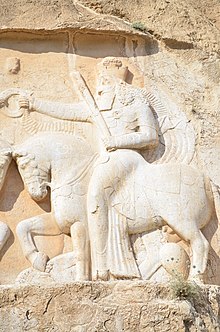

TYPE: God of Light
ORIGIN: Persian (Iran)
KNOWN PERIOD OF WORSHIP: Circa 1500BCE to end of Roman Empire period, circa 400 CE
SYNONYMS: None
CENTER(S) OF CULT: Throughout ancient Near East during Persian and Roman Empire periods.
ART REFERENCES: Various sculptures and reliefs
LITERARY SOURCES: Avestia
INFORMATION: Ahura Mazda probably originates as the Hindu Vedic god Varuna. In Persian religion he becomes the god of light and truth in the Zoroastrian concept of dualism. His chief attendant god is Mithra(s) and his adversary is Ahriman, the god of darkness. According to tradition his first creation, a wild bull, was confined to a cave by Mithras. When it escaped, Mithras was charged with finding and slaying it. The bull's blood fell to the earth and from the drops life formed. Ahura Mazda is not mentions in Roman Mithraic inscriptions but he is, by implication, the central figure in Mithraism. In the Mithraeum in Rome (S. Prisca), Ahura Mazda is considered to be a reclining figure on whom Mithras attends.
Although never popular among the civilian population, Mithraism spread under Flavius and was widespread among the Roman military, though it always enjoyed a greater following in the east than in the west. It was one symptom of the more general Roman return to sun worship. In 307 CE a sanctuary on the Danube was dedicated to Mithras (and Ahura Mazda) in an effort to sustain military power in the empire.